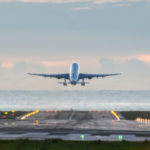German start-up Odonata has publicly unveiled its hydrogen-powered aircraft which it hopes will “revolutionise” the emerging advanced air mobility sector.
Showcasing designs for the platform for the first time at AIRTEC aerospace fair in Augsburg, southern Germany, Odonata said its vertical take-off aircraft takes off like a helicopter but flies like an aeroplane.
With a range of 1,000 km and a payload of 800 kg, the aircraft could link destinations such as Paris and London, from Frankfurt.
As well as conventional passenger transport, logistics, cargo traffic and medical care are also future possible use cases.
Odonata seeks to revolutionise regional air mobility
Speaking to FINN, Dennis Furcheim, CEO of Odonata, said: “For nearly three years, we’ve operated covertly, and AIRTEC marks our inaugural foray into the public eye.
“Prior to this unveiling, we diligently addressed the conceptualisation of intricate technical details. Our vision was clear: to revolutionise regional air mobility. We asked, ‘What must our eVTOL aircraft possess?’ – high range, substantial payload, swift turnarounds, paramount safety, and ultimately, profitability.
“These criteria coalesced into our current concept, designed to seamlessly transport people and goods fast from any point to another. Starting like a helicopter and flying like a plane.”
The Odonata aircraft is designed with a large cabin that offers enough space for nine people (eight passengers plus pilot) and their luggage.
Flight testing
Furcheim added: “Many existing eVTOL companies primarily target travel between cities and airports. We challenge this approach, questioning the need for the cumbersome journey from cities to airports, only to board another plane.
“While large airplanes and airports remain essential for long-haul flights, our niche lies in short-haul flights, a cornerstone of European travel. Within our 1,000-kilometre range, direct flights become a reality, making smaller airports an ideal conduit for disrupting the current regional aviation paradigm.”
Odonata is undertaking flight testing and a significant portion of the company’s development has been conducted in-house.
A one-seventh scale model has been constructed to rigorously test the transition phase, including wind tunnel testing. The next phase involves securing additional funding to construct a powertrain test bench and a larger scale model.
Subscribe to the FINN weekly newsletter
You may also be interested in:
Dufour Aerospace’s Aero2 aims to be ‘Swiss Army Knife of drones’

